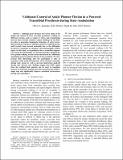Volitional control of ankle plantar flexion in a powered transtibial prosthesis during stair-ambulation
Author(s)
Herr, Hugh M; Kannape, Oliver Alan
DownloadHerr_Volitional control.pdf (287.8Kb)
OPEN_ACCESS_POLICY
Open Access Policy
Creative Commons Attribution-Noncommercial-Share Alike
Terms of use
Metadata
Show full item recordAbstract
Although great advances have been made in the design and control of lower extremity prostheses, walking on different terrains, such as ramps or stairs, and transitioning between these terrains remains a major challenge for the field. In order to generalize biomimetic behaviour of active lower-limb prostheses top-down volitional control is required but has until recently been deemed unfeasible due to the difficulties involved in acquiring an adequate electromyographic (EMG) signal. In this study, we hypothesize that a transtibial amputee can extend the functionality of a hybrid controller, designed for level ground walking, to stair ascent and descent by volitionally modulating powered plantar-flexion of the prosthesis. We here present data illustrating that the participant is able to reproduce ankle push-off behaviour of the intrinsic controller during stair ascent as well as prevent inadvertent push-off during stair descent. Our findings suggest that EMG signal from the residual limb muscles can be used to transition between level-ground walking and stair ascent/descent within a single step and significantly improve prosthesis performance during stair-ambulation.
Date issued
2014-11Department
Program in Media Arts and Sciences (Massachusetts Institute of Technology)Journal
2014 36th Annual International Conference of the IEEE Engineering in Medicine and Biology Society
Publisher
Institute of Electrical and Electronics Engineers
Citation
Kannape, Oliver A., and Hugh M. Herr. “Volitional Control of Ankle Plantar Flexion in a Powered Transtibial Prosthesis during Stair-Ambulation.” 2014 36th Annual International Conference of the IEEE Engineering in Medicine and Biology Society. IEEE, 2014. 1662–1665. © 2017 IEEE
Version: Author's final manuscript
ISBN
978-1-4244-7929-0